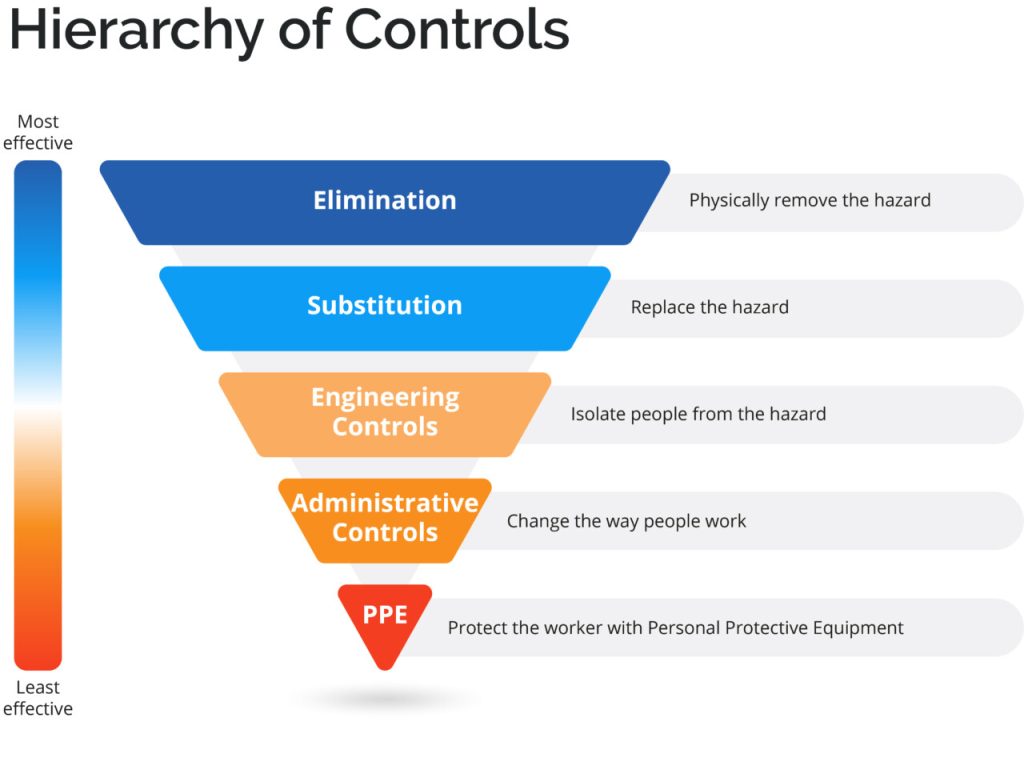Most organizations have programs for tracking, managing, and communicating the hazards of their workplace chemicals. While these programs help maintain a safe environment, many organizations could do more to prevent hazardous exposure from becoming an issue in the first place through the hierarchy of controls for chemical management and a corresponding chemical materials approval and screening process. With a defined process to screen, authorize, and purchase new and existing materials, your organization can better control and mitigate employee health and safety risk.
What is Hierarchy of Controls for Chemical Management?
As a guideline, many organizations follow the hierarchy of controls to identify the most effective and least effective methods to reduce chemical hazards. The National Institute for Occupational Safety and Health defines the five layers of hierarchy of controls for chemical management as elimination, substitution, engineering controls, administrative controls, and personal protective equipment:

How Chemical Approval Process Works With Hierarchy of Controls
Clearly, eliminating hazardous chemicals from even entering the workplace is the most effective way to keep your employees safe. If a dangerous chemical never enters the workplace, employees don’t face any risks. But without a strong chemical purchasing approval process in place, organizations lack the necessary visibility to know which chemicals to ban.
Additionally, if a chemical undergoes any hazardous changes, most environmental, health, and safety (EHS) professionals do not learn about these alterations until the material is in use. Without a material purchase screening processes, they have no way to prepare – whether it be complete elimination or adding PPE requirements.
Of course, your organization can’t eliminate all hazardous chemicals. Some hazardous chemicals inevitably end up in the workplace, which is why those alternative control mechanisms are needed. A chemical approval and screening process does just that by giving a health and safety team the information they need to monitor requests, provide chemical information for expert review, offer feedback, and prepare for adjustments in chemical hazards to their operations and employees. From there, the health and safety team can effectively implement engineering controls, administrative controls, and PPE requirements that support a safe work environment.
For example, a chemical approval process may identify a dangerous yet necessary workplace chemical. This gives the health and safety team a chance to implement new processes to minimize contact workers have with the chemical, such as using wet methods to reduce dust generation, improving ventilation, or introducing fume hoods. Or in other cases, the health and safety team may decide to require protective clothing or respiratory protection or rotate job assignments to prevent overexposure.
You might also like: Reducing Chemical Management Risk with Trusted Chemical Property and Safety Data
Implementing an Effective Chemical Approval Program
With your employees’ health and safety riding on an effective chemical approval program, it’s important to invest in a robust system that can automate cross-checking regulatory lists, track inventories, and oversee location management. While organizations traditionally relied on spreadsheets to handle these functions, this type of manual system can lead to errors, require excessive hours of manpower, and lack central oversight. Instead, today’s most sophisticated organizations rely on SaaS-based chemical management software for their chemical approval process.
Your chemical management questions, answered
Chemical management is a priority for so many organizations. Yet, running an effective chemical management program remains challenging due to the degree of complexity involved. That’s why we teamed up with our friends at Verisk 3E to answer five of the most frequently asked questions we get about managing chemicals effectively. Check out the answers here: 5 Keys to Best-in-Class Chemical Management









